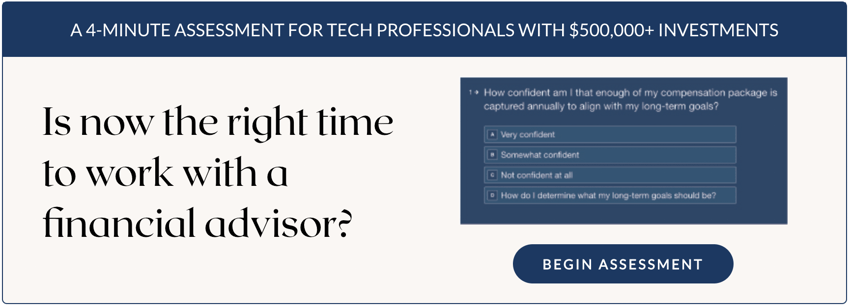As an independent financial advisory firm working with clients in Silicon Valley over the last three decades, we’ve witnessed the evolution of benefit packages offered to tech and business professionals. The most recent Tech Boom (2010’s) created high demand for top-talent, and companies responded with creative, albeit often complex, incentives for employees.
Whether it be evaluating stock options for startup tech company employees or understanding tax planning strategies for restricted stock units (RSUs), it can be difficult to manage all of the various incentives, minimize tax liabilities, and achieve your long-term objectives.
In this article, we examine taxes and Employee Stock Purchase Plans, or ESPP - a common benefit offered to business and tech professionals. Here's what you need to know as an employee.
Find out if now is the time to start working with a financial advisor.
Take the quiz →
What is an Employee Stock Purchase Plan, and how does it work?
An employee stock purchase plan (ESPP) is a benefit program in which employees can purchase company stock at a discounted price. Instead of determining the number of shares, you decide how much money you will be contributing, and the funds are typically deducted from your payroll.
It generally works like this:
- Enrollment: You enroll in the program. You “opt in” prior to the company’s established start date, usually in 6-month intervals.
- Offering Date and Discount: At the established start date, or the “offering date,” the price of the stock is determined on that date. This starts as your baseline from which you will get your discount.
- Stock Purchase Discount: The employee discount is predetermined, i.e., 15% at the beginning of the program; however, it does not take effect until the end of the program (see below).
- Determine Contribution Amount: At the time of opt-in, you decide what percentage of your income to dedicate to the program. There is a limit, usually a max amount in terms of percentage and $ dollars. The most common limit we see is a $25,000 maximum contribution amount annually.
- Locked in Contribution: Once you start, while the price of the stock will inevitably change, you cannot decrease or increase your contribution determined at the beginning.
- Deductions: Once you enroll, your money is taken directly out of your paycheck. In most cases, the money is deducted after or post-taxes (not pre-tax like other deductions, e.g.,your 401k). Your pay is withheld throughout the contribution period, usually 6-months.
- End of Program: At the end of 6-months, your contributions throughout the period will automatically convert to stocks for the company. These stocks will be purchased, and the shares will be delivered to you.
- How the stocks will be discounted: The stocks will be purchased at the plan discount, at the lesser of the price: either the price at offering date, or the price at the end of the period. If the price decreases from the start, you’ll get the discount at the current price (less than the start). If it increases from the start, you’ll still get the discount at the starting price (less than the current).
Example Scenarios
Let’s look at two scenarios, one where the stock price decreases over the program duration and one where it increases.
Scenario 1
| Discount % | Stock Price at Offering Date | Stock Price at End of Program | Your Determined Contribution (Total 6 Months) |
| 15% | $50.00 | $45.00 | $1,000.00 |
In this scenario, you contribute $1,000 over 6 months. The offering date price was $50.00, and at the end of the program, it was $45.00. You get a 15% discount on the lesser of the two, or in this case, $45.00/share.
At the end of the program, your $1,000 contribution will be converted into stock shares at $38.25/share (15% off $45.00).
Scenario 2
| Discount % | Stock Price at Offering Date | Stock Price at End of Program | Your Determined Contribution (Total 6 Months) |
| 15% | $50.00 | $60.00 | $1,000.00 |
In this second scenario, you still have contributed $1,000 over 6 months; however, the stock has increased in value to $60.00/share. Since in this case the offering date price is less, you get the 15% discount on the $50.00/share.
At the end of the program, your $1,000 contribution will be converted into stock shares at $42.50/share (15% off $50.00).
Selling the Shares Right Away: What You Need to Understand About Taxes
Now you have your shares. What if you sold them right away?
Sell Right Away - Key Tax Takeaway:
You’ll have to pay ordinary income tax on the discount you received. In our example above, the discount was 15%, so you would have to pay taxes on the “gain” or “profit” you made. You would NOT have to pay taxes on the actual stocks themselves, since you already purchased them (with post-tax payroll contributions!)
In Scenario 1 above, you received a 15% discount on $45.00/share, or $38.25/share. You would owe taxes on that 15%, or $6.75.
Sell Right Away - Key Tax Takeaway:
If your stock increased in price during the program, you’ll also have to factor in taxes on the difference between your actual purchase price and market price when you sell.
In Scenario 2 above, you received a 15% discount on $50.00/share, or $42.50/share. If you sell at the new market price of $60.00, you’ll have to pay taxes on the difference per share: $60.00 - $42.50 = Difference of $17.60.
Holding the Shares & Selling Later: Qualified vs Disqualified Dispositions
Let’s say you choose to strategically hold the shares, or you’ve had shares piling up from years of participating in ESPPs and holding them. How do taxes work?
Qualified Disposition - Key Tax Takeaway:
In order to qualify for the most advantageous tax, or long-term capital gains tax, you have to wait to sell the shares until 12 months after they are purchased and a full 24 months after the program starts (offering date).
The key point here is that the long-term capital gains tax rate is lower than the ordinary income tax rate. For the employee selling shares right away, they pay ordinary income tax on the discount and the increase in share price. For employees who sell qualifying disposition shares, they still have to pay ordinary income tax on the discount percentage, but under current tax laws, they pay a lower capital gains rate on the difference between actual purchase price and market value at the time of the sale.
Let’s take a look again at Scenario 2. Instead of selling right away, let’s imagine the employee holds their shares for at least 1 year after purchase and 2 years after offering.
| Stock Price at Offering Date | Stock Price at End of Program (Purchase Price) | Market Value Stock Price at Time of Sale | Ordinary Income Tax Owed | Long-Term Capital Gains Tax Owed |
| $50.00 | $42.50 | $100.00 | $50 - $42.50 = $7.50 per share | $100 - $50 = $50 per share |
The employee is taxed on the $7.50 per share as ordinary income tax, and must pay a long-term capital gains tax on the $50 per share.
Disqualified Disposition - Key Tax Takeaway
Disqualified dispositions are subject to higher short-term capital gains tax. Depending on how long you’ve held the shares, if they are subject to short-term holding requirements, you will pay a higher rate on the difference between purchase price and market value price at the time of sale.
Analyzing whether or not your ESPP shares are qualified or disqualified dispositions can quickly become complicated, particularly if you are consistently receiving and participating in programs on a 6-month rotating basis. A financial advisor can help you build a plan for how to minimize potential tax liabilities and create a strategy for when and how to sell your shares.
ESPP Strategies & Key Takeaways to Consider:
Guaranteed Return
If you have the income, think of ESPP as a short-term savings account: Think about this - if you sell right away, you will have a guaranteed rate of return. However much you contribute, whatever happens with the stock price, and whatever you choose to do upon receiving the shares, you are guaranteed at least a return equal to the program discount percentage. In the examples above, you contribute $1000, pay for stocks at 15% reduced rate, and then sell for the actual rate…giving you a guaranteed 15% return.
Not great for someone who struggles with cash flow
Since the money is automatically deducted from your paycheck and it is not accessible, ESPP is typically not good for someone with cash flow issues.
Have a lot of shares?
You should go through the different tax situations and build a strategy for which shares to sell, at what time to minimize tax liabilities.
What Our Experience Tells Us
Much like restricted stock units or stock options, ESPPs can become burdensome to manage so many variables on your own. You don’t want to miss out on opportunities, but you also don’t want to get hit with an unexpected tax liability that prevents you from accomplishing your goals.
We encourage you to reach out to a financial advisor and talk through how they can help you navigate some of these complexities. You can always reach out to us and set up a complimentary consultation. In addition to ESPPs, we are well versed in handling other types of stock compensation benefits such as RSU or stock options.
The material has been gathered from sources believed to be reliable, however MA Private Wealth cannot guarantee the accuracy or completeness of such information, and certain information presented here may have been condensed or summarized from its original source. The outcomes discussed herein are for illustrative purposes only and are not representative of any one client’s experience. Actual tax savings may vary materially than those portrayed herein, and no portion of this information is to be construed as personalized financial advice. MA Private Wealth does not provide tax or legal advice, and nothing contained in these materials should be taken as such. To determine which tax planning strategies may be appropriate for you, consult your tax advisor. Advisory services are only offered to clients or prospective clients where MA Private Wealth and its representatives are properly licensed or exempt from licensure. No advice may be rendered by MA Private Wealth unless a client service agreement is in place.

